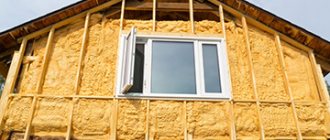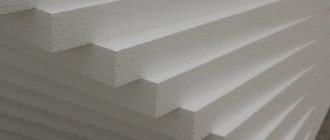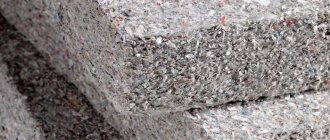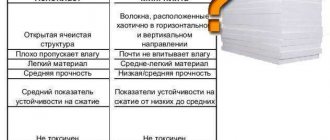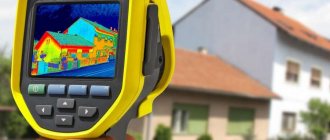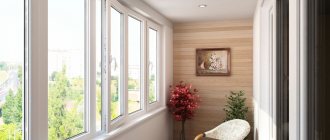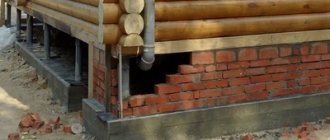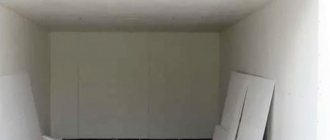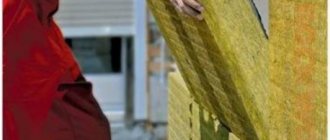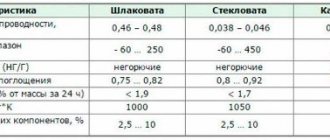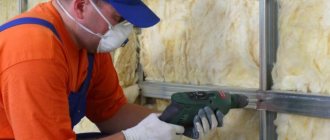X
Today there is no need to explain to anyone: the better the house is insulated, the less you will have to pay for its heating. Another question: what is the best way to insulate?
Read our material about different types of wall insulation. More often than others, builders prefer two insulation materials: expanded polystyrene, or polystyrene foam, and mineral wool. Each of them has its own pros and cons and, of course, myths. Today we’ll talk and debunk myths about facade insulation with foam plastic.
Myth No. 1. Insulating a façade is expensive
If you decide that it is absolutely necessary to insulate the facade and there is no return to your decision, the time will come to purchase materials. In order to cover the entire house, you will need relatively large amounts of money. Somewhere between $2-2.5 thousand per 100 m2. Such is the cost of materials and finishing work.
Helpful information:
- How to remove old paint from walls
- Insulating an apartment and saving heat
- Preparing walls before wallpapering
- Preparing walls and floors for ceramic tiles
- Insulation and soundproofing of a house with Izoplat
- The best ways to prepare walls for liquid wallpaper
However, after 5 years you will return this money a hundredfold thanks to heat savings and, accordingly, reduction in heating costs. And if you consider that a facade covered with foam plastic will serve you for at least 25 years, then you will forget about the huge 3a gas bills.
Myth No. 2. Mineral wool is cheaper
At this point there is a substitution of witnesses. Which mineral wool is cheaper? The answer is - in rolls. To make the house as warm as if you covered it with foam plastic, you will have to use a huge amount of rolled mineral wool, which will be much more expensive than in the case of foam plastic. Often facades are insulated with mineral wool boards, which are much more expensive than foam boards.
Wall insulation technology
Also, mineral wool boards are more difficult to install, which indicates the cost-effectiveness of foam insulation.
Insulation from the outside and myths about insulating a wooden house with polystyrene foam
Internal insulation is tempting because you can do it yourself, saving on calling a specialist (if you need to insulate the second or third floor of the house). However, many people forget that it contributes to:
- Loss of usable area.
- Deterioration of the internal microclimate.
- Moisture problems in the room.
In addition, internal wall insulation provides food for the most popular “horror story” about insulating houses with polystyrene foam.
According to popular belief, the low vapor permeability of polystyrene foam when insulating a wooden house can give an unpleasant effect in the form of moisture condensation.
Indeed, when the house is insulated internally with polystyrene foam, condensation does occur. And it is explained by the temperature difference.
In winter, the air in the room is heated to an average of +20. Outside the window the thermometer shows -20. The polystyrene foam installed from the inside is heated by room heat, and at the point of contact with the frozen outer wall a temperature contrast is created, which will cause moisture accumulation. And with it - the development of fungus, mold and the gradual destruction of the outer walls of the building.
Thus, insulating the house with polystyrene foam from the outside is a more advantageous option. However, it is worth noting that external insulation of a building with polystyrene foam will cost slightly more than a similar procedure using rolled materials. But in return you will receive reliability and effective heat conservation. And doing the insulation yourself will be much easier.
And this article talks about insulating a wooden house from the inside.
Myth No. 3. It doesn’t matter what you use for insulation.
The most wrong opinion that could ever be thought up or expressed. Your comfort will depend on the quality of the material in the future. Therefore, before choosing it, remember a few important rules:
- choose material from trusted, well-known manufacturers;
- the polystyrene foam you choose must be produced in a factory that provides certification for its products. This way you will receive quality material;
- the reinforcing mesh should not have low density, be fragile or too cheap;
- facade dowels (fungi) must be made of good plastic, flexible, frost-resistant, elastic, and also be at least 50 mm longer than the foam;
- decorative plaster and paint applied to it must be of high quality.
Stages of do-it-yourself foam insulation work
treat with antiseptic compounds
- To install a ventilated facade, it is necessary to make a vertical sheathing. To do this, wooden boards are nailed to the walls so that the insulation fits as tightly as possible, the distance between them is 5-8 mm less than the width of the boards.
- A vapor barrier film is stapled onto the top of the sheathing.
- Counter-lattice slats are placed on the vapor barrier, which serves to create a ventilation gap between the wall and the insulation.
- Foam plastic is placed between the racks, which should fit tightly to the slats. The gaps between the plates must be filled with foam.
- A diffuse membrane is laid on top of the insulation. The smooth side of the material should face the wall. The membrane ensures good air circulation and removal of excess moisture from the house.
- The joints between the sheets are taped with adhesive tape.
- The last stage is cladding with decorative material. Siding, facade panels, lining, etc. can be used as finishing.
When externally insulating a log house with polystyrene foam, which due to the natural roundness of the logs has uneven walls, a two-layer sheathing is made. To do this, first install vertical posts, and then, after laying thermal insulation boards in them, they are additionally secured with horizontal guides. This fastening ensures a tighter fit of the insulation and makes the structure even more reliable.
When thermally insulating a log house, there is no need to install a counter-lattice, since a natural air gap is created between the logs and the insulation.
Myth No. 4. A facade insulated with foam plastic “does not breathe”
By the way, the concept of a wall that “breathes” as such does not exist in the technical environment. This term, torn from scientific journalism, was picked up by builders, after which it happily went to the people. The fact is that the wall as such cannot “breathe”; ventilation performs this function in the house. The share of “breathing” of the walls accounts for from 0.5% to almost 3% of the entire ventilation system of the house. Therefore, no wall can replace ventilation. If we take specifically the popular concept of “breathing walls,” it means the following: the insulation itself cannot “breathe” at all, that’s why it is a heat-insulating material, the system “breathes.” The design of the facade, thanks to the upper air gaps between the facade, foam plastic and side joints, provides a high-quality (necessary for this type of structure) air flow for ventilation of the facade, thereby eliminating the possibility of condensation.
Features of insulation using foam plastic
If you plan to insulate external walls with polystyrene foam, they become multi-layered. When constructing a multilayer wall, the following points should be taken into account in order to avoid operational problems later:
- the thickness of the foam layer must be calculated as accurately as possible;
- the thickness of the insulation must be optimal and at the point of contact with the wall the temperature must exceed the temperature of condensation formation;
- if moisture is allowed to form between the masonry and the insulation, the masonry will begin to deteriorate over time;
- as mentioned earlier, foam plastic practically does not allow air to pass through, so the walls cannot “breathe”. You should take care of good ventilation if you choose this type of insulation.
Myth No. 5• Polystyrene foam is a highly flammable material
Since expanded polystyrene, or polystyrene foam, is a material with polymer additives, it is flammable. But when used correctly and in compliance with installation and operation requirements, as well as fire safety, the risk of fire is reduced to a minimum. Since the flammability of foam boards is determined not only by their properties, but also by combination with other materials, as well as the existence of the necessary protective layers.
How to insulate a wall in an apartment from the inside - consider all the options
Interesting fact. In order for the foam to ignite, a temperature of +491°C is required. For comparison, the ignition temperature of wood is +260°C (1.8 times lower), paper - +230°C (2.1 times lower than that of foam plastic). In addition, when burning, polystyrene foam releases from 1000 to 3000 MJ/m3 of thermal energy, dry wood - 7000-8000 MJ/m3. In addition, modern polystyrene foam contains special additives that reduce its flammability, so it will not burn with an open flame.
PPS or EPPS?
PPS - polystyrene foam familiar to most
Of the many heat-insulating materials, expanded polystyrene (EPS), also known as foamed polystyrene, is the most suitable for independent work. This material is produced either in the form of slabs pressed from granules, which are colloquially called polystyrene foam, or in the form of slabs of extruded polystyrene foam (EPS). The latter is 3-4 times more expensive ($12-16 per cubic meter versus about $4), but has lower thermal conductivity and is several times more durable. Due to their relatively high strength, EPS boards are produced with a quarter, which is very important: with or without gluing the joints, the formation of cold bridges at the joints between the boards is eliminated.
Which material to choose? In a private house, it is better to insulate the walls outside for the sake of economy using PPS : by forming a closed box, the insulation as a whole will gain sufficient strength. If you plan to apply decorative plaster on top of the basic exterior plaster, and you have money for repairs, then for the sake of higher strength it is better to take EPS.
EPPS
In a city apartment, the choice depends primarily on the climatic conditions of the area: in regions with strong winds and precipitation, you need to work harder and order EPS . It adheres more firmly to both glue and fungi, and its moisture absorption is 0.1-0.4% by weight versus 1.5-3.5% for PPS. But in areas with an even climate, simple PPS is not prohibited - the likelihood of damage to the coating at height is extremely low, and relief plaster is not done on the outside of the floors; it is still not visible from below.
Myth No. 6. The fragility of polystyrene foam
It is too early to say that this material has been tested by time, because its production was mastered only in the 1950s. However, laboratory studies have shown that polystyrene foam boards are designed for 80 conventional years of operation. In addition, it should be remembered that polystyrene foam is a polymer material inert to biological destruction, so it is quite durable. It can have only two “enemies”: UV radiation and mechanical influences. However, you can protect yourself from them by covering polystyrene foam with a reinforcing mesh with plaster, clinker tiles and other facing materials applied on top.
Myth No. 7. Foam plastic is not environmentally friendly insulation
Foamed polystyrene foam is a homogeneous foaming product without the use of chemical additives and form-building substances. It does not evaporate during operation, has no harmful radiation, and is non-toxic. Moreover, today polystyrene foam is considered the most environmentally friendly thermal insulation material safe for health. Only when the material is smoldering can harmful substances be released, which can be prevented by simply observing fire safety rules.
In addition, containing no gas other than air, polystyrene foam guarantees the absence of allergies or hidden diseases.
Pros and cons of expanded polystyrene
It is necessary to understand that styrene, which is a by-product from the oil industry, is used to make the material. Therefore, it cannot be said to be an absolutely environmentally friendly material. It is produced only industrially; artisanal and home production of polystyrene foam boards is impossible.
However, extruded polystyrene has a number of significant advantages:
- low cost compared to other insulation materials;
- high thermal insulation rates due to the dense structure;
- low weight and good compression resistance;
- has excellent soundproofing qualities;
- moisture resistance;
- a wide choice depending on its characteristics: density, thickness, surface structure, end edges (straight or groove), color palette;
- able to interact with various adhesives, lime, gypsum, cement, salt, bleach, water-based paint;
- does not rot (decomposition of the material in the ground can exceed 10 years);
- fire resistant (fire temperature is 2 times higher than wood);
- durability (manufacturers guarantee a period of operation from 15 to 60 years);
- no need to use special tools for cutting and installation.
The material is created artificially and has no natural origin. It contains many chemical additives and compounds that are unknown to the average consumer, so in addition to its advantages, polystyrene foam has disadvantages:
- reacts negatively to ultraviolet radiation, from which the structure is destroyed over time and the original characteristics are lost;
- reacts negatively to gasoline, fuel oil and various types of solvents;
- susceptible to destruction by termites and rodents;
- in case of combustion, a gas is released, which is many times more dangerous than carbon dioxide (it is fatal for humans).
Myth No. 8. Decorative plaster over insulation is not necessary - just paint is enough
The protective properties of painting can be defined as follows: good protection against temperature changes and chemical influences. However, this cannot be compared with the protective properties of reinforcing layers and plaster. The reinforcing mesh will first ensure the strength of the system and prevent further cracking of the plaster, and the plaster itself will protect the foam from ultraviolet radiation and mechanical damage. The facade will retain its attractive appearance for many years. In addition, you can paint and repaint it in any color.
Myth No. 9. Insulating walls will not significantly increase heat in the house
This statement is both true and false at the same time. Any insulation is not a heater. And by definition, it does not increase the amount of heat in the house. However, it helps retain this same heat indoors. those. You don't gain, but you don't lose either. Without insulating the façade, you will be “heating the street.” In some cases, with proper installation of foam plastic insulation, it retains up to 40% of the heat that would go outside if such a procedure as facade insulation was neglected.
KNAUF insulation: technical characteristics
What is the best way to insulate with polystyrene foam - inside or outside?
If you go to any construction forum and read topics about insulation from the inside and outside, you can break your head. Some say that insulation can only be done from the outside, others say that insulation from the inside does not bode well.
Now I will try to explain in detail why it is still better to insulate walls from the outside. To do this, I drew a diagram of the insulation of the wall from different sides and the effect of adverse atmospheric influences on it.
The dew point is the point where water vapor in the air turns into water droplets. In other words, this is the place where condensation begins to collect.
Let’s say it’s -25 outside, and +20 in the house. In the case of insulation from the inside, the wall will be almost completely absorbed by negative temperature, and the dew point will move closer to the insulation, i.e. inside the room. Naturally, condensation will begin to appear between the insulation and the wall, which will be absorbed by it, will not have time to dry and the wall will always be wet.
And from the school physics course we know that at subzero temperatures, water freezes, turning into ice, thereby gradually destroying the wall itself.
If we insulate the wall from the outside, then we will move the dew point closer to the street, which will allow home heat to protect the wall from negative influences. In this case, the wall will be much warmer and almost dry.
There are times when it is necessary to insulate walls with polystyrene foam, but for some reason this cannot be done outside. In this case, following the technology, you can insulate the wall from the inside of the house.
Myth No. 10. It doesn’t matter who insulates
You can insulate the house from the outside yourself - it’s up to you. However, it is better to call professionals for this matter. At the same time, the quality of the work done depends on the correct choice of the façade designer. Unscrupulous façade providers can perform a number of manipulations. For example, tile adhesive is much cheaper than high-quality thermal insulation adhesive. It glues well, but after a few months its effect will stop and the foam will remain hanging only on the dowels. remember, 5-6 dowels should be used per 1 m2 of polystyrene foam. Unscrupulous craftsmen use 2-3 pieces each, and take the rest with them.
Installation of foam plastic
There are 2 main ways to insulate a wooden house with polystyrene foam:
- using lathing;
- glue landing.
Fastening polystyrene foam boards using lathing
When insulating a wooden house with foam plastic from the outside, the technology of creating ventilated facades has proven itself well.
Main stages of work:
- To create the sheathing, vertically arranged boards are placed on the insulated wall. To calculate the distance between them, you need to add the thickness of the slats to the width of the foam and reduce the resulting amount by 5 mm.
- A vapor barrier film (vapor barrier) is attached on top of the boards using a stapler.
- Slats are nailed onto the vapor barrier using nails. The distance between the slats should be slightly less than the width of the insulation.
- Expanded polystyrene boards are installed tightly between the slats.
- To seal the foam, dowels in the shape of a fungus are used. They are screwed in five places. The cracks should be filled with foam, and after it has dried, a diffusion membrane should be laid. It is she who removes excess moisture from the house. The smooth side of the membrane is attached to the wall to ensure proper air circulation. The joints are taped with any available adhesive tape.
- The final stage is exterior finishing. Most often, thin-layer plaster, siding or lining are used as materials. Their use makes it possible to increase the fire resistance of walls.
Glue landing
External insulation with foam plastic using the gluing method is carried out without creating a frame; the slabs are attached to the walls themselves. The disadvantage of this method is the need to hide the joints of the slabs and dowel caps under putty. Plus ─ no need to waste time creating the sheathing.
Installation procedure:
- For people without experience, it is better to start working on foam insulation from a less visible side of the house. First, stir the glue and leave for 5 minutes, then mix it again. For greater savings, cement mortar is used as a fastening material. The starting profile is attached to the prepared wall in a horizontal position.
- Using a spatula, apply the glue in a thin strip along the entire perimeter of the slab, and then dotted it in several places in the center. Then press it firmly against the wall, checking the evenness using a building level.
- If necessary, level with light patting of the hand or using other available means.
- Rows of expanded polystyrene should be laid horizontally, starting from the bottom, in a checkerboard pattern. They cut the slabs with a knife. Openings around windows and doors are lined with a layer of non-combustible insulation. It is advisable to cover the resulting cracks with glue.
- After the glue has completely dried, which usually happens after 1-2 days, the insulation boards need to be secured. For this purpose, mushroom dowels are used. The corners also need to be strengthened by placing the perforated corner on glue. You cannot waste time with finishing work, since polystyrene foam loses its properties in the sun. Before starting work, the gaps between the plates are foamed. Polyurethane foam is chosen without toluene content, because it is dangerous for polystyrene foam. The reinforcing mesh is glued to the wall with a slight margin. Do the same with the next section.
- The surface is rubbed with sandpaper after 2-3 days, when the glue has dried, then finishing is carried out.
As you can see, foam plastic as insulation for the outside of a wooden house has its pros and cons.
How to attach polystyrene foam to wooden walls of a house
Insulation of the facade of a wooden house is carried out using frame technology. It consists of the construction of a frame into which the insulation is placed. All work is carried out in stages.
An example of a frame system for insulating a house
